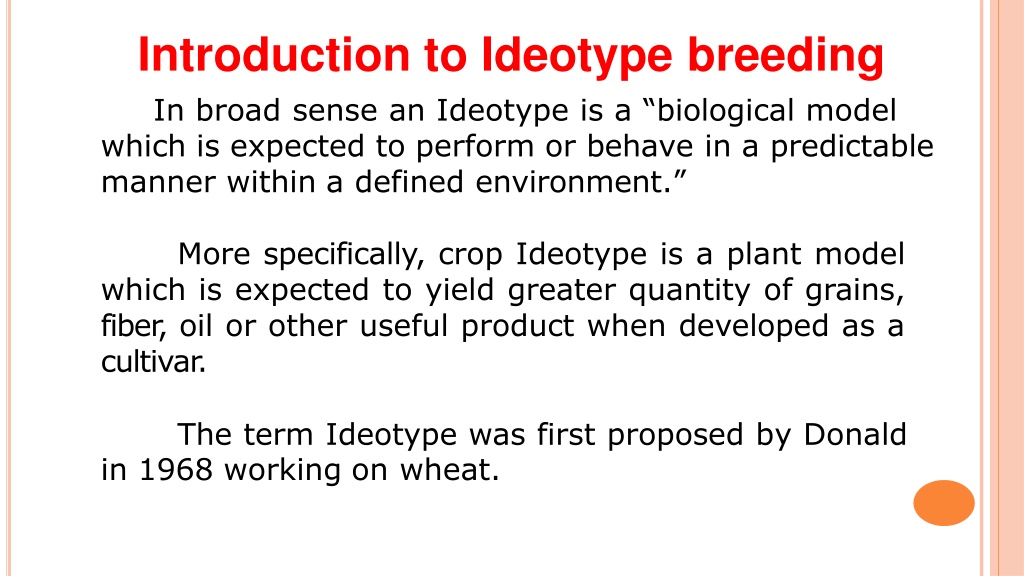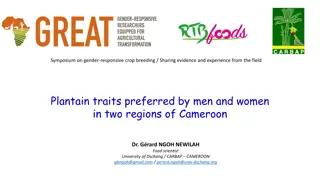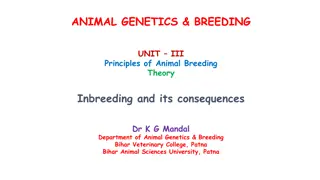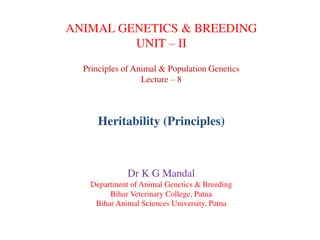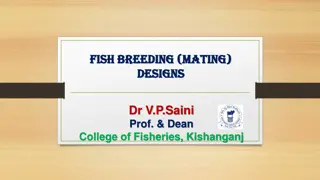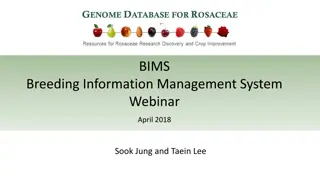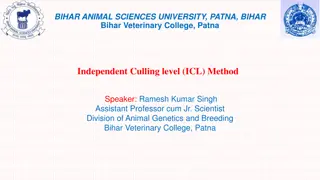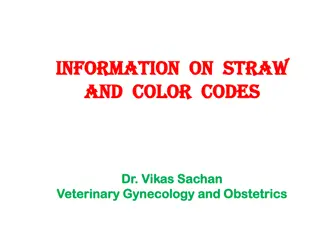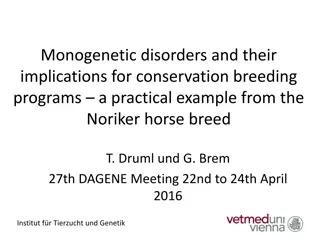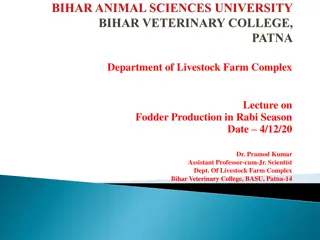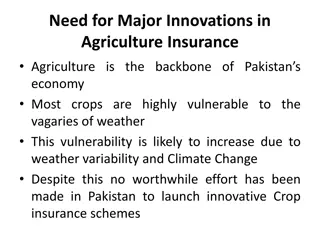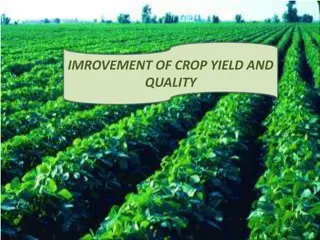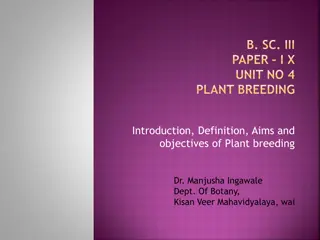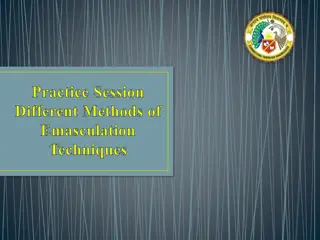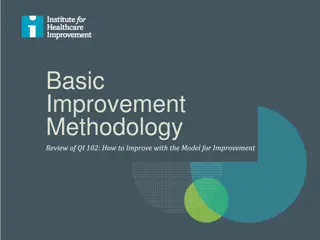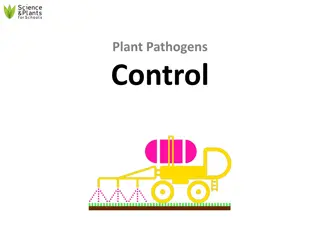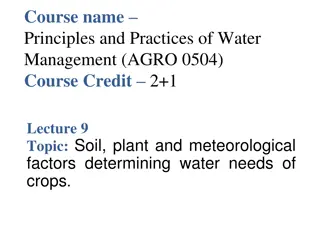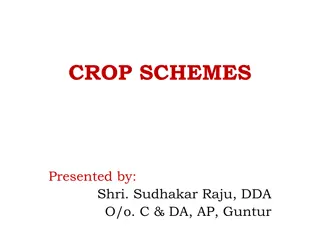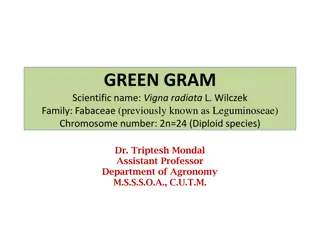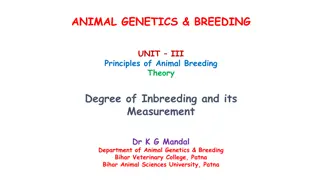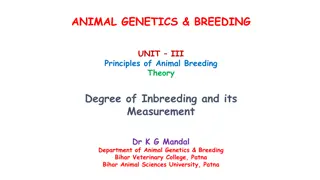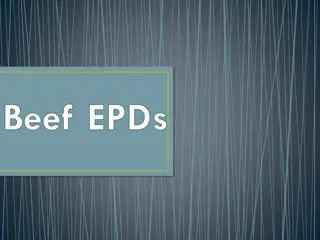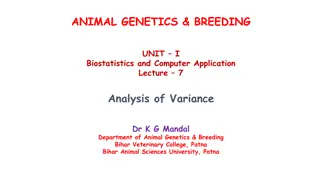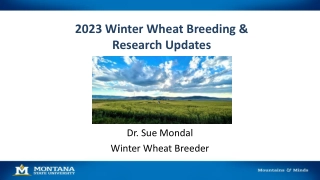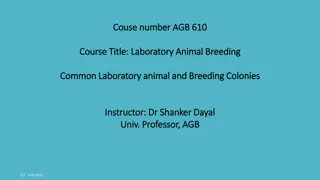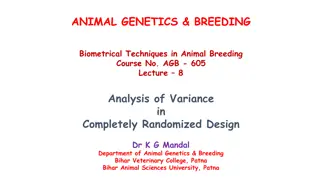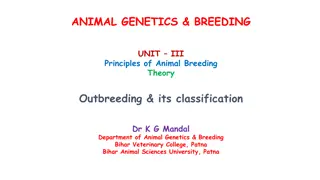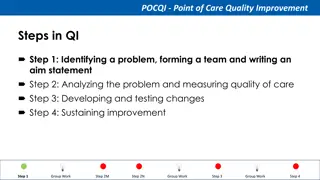Understanding Ideotype Breeding in Crop Improvement
Ideotype breeding involves developing plant models with specific traits to optimize the yield of crops in various environments. Key steps include conceptual model development, base material selection, incorporation of desirable traits, and model plant type selection. This method offers a systematic approach to cultivar development for enhanced productivity and adaptability in different conditions.
Download Presentation

Please find below an Image/Link to download the presentation.
The content on the website is provided AS IS for your information and personal use only. It may not be sold, licensed, or shared on other websites without obtaining consent from the author. Download presentation by click this link. If you encounter any issues during the download, it is possible that the publisher has removed the file from their server.
E N D
Presentation Transcript
Introduction to Ideotype breeding In broad sense an Ideotype is a biological model which is expected to perform or behave in a predictable manner within a defined environment. More specifically, crop Ideotype is a plant model which is expected to yield greater quantity of grains, fiber, oil or other useful product when developed as a cultivar. The term Ideotype was first proposed by Donald in 1968 working on wheat.
MAIN POINT OF IDEOTYPE : Crop Ideotype refers to model plants for specific environment. Ideotype differs from Idiotype. It include morphological as well as physiological and biochemical traits. Ideot ype is a moving goal. It is difficult and slow method of cultivar development.
STEPS IN IDEOTYPE BREEDING 1) Development of conceptual theoretical model. 2) Selection of base material. 3)Incorporation of desirable characters into single genotype. 4) Selection of ideal or model plant type.
DEVELOPMENT OF CONCEPTUAL THEORETICAL MODEL Ideotype consists of various morphological and physiological traits. The values of various morphological and physiological traits are specified to develop a conceptual theoretical model. For example, Plant height is important in fodder crops. Maturity duration is important in rainfed. Similarly leaf number, leaf angle, leaf size, photosynthetic rate,etc are specified for each crops and situation.
SELECTION OF BASE MATERIAL Selection of base material is an important step after development of conceptual model of Ideotype. Genotype to be used in devising a model plant type should have broad genetic base and wider adaptability so that the new plant type can be successfully grown over a wide range of environmental condition with stable yield. Genotypes for plant stature, maturity duration, leaf size, and angles are selected from the global gene pool of the concerned crop species. Genotypes resistant or tolerant to drought, soil salinity, alkalinity, disease and insects are selected from the gene pool with the cooperation of physiologist, soil scientist, pathologist and entomologist.
INCORPORATION OF DESIRABLETRAITS The next important step is combining of various morphological and physiological traits from different selected genotypes into single genotype. Knowledge of the association between various characters is essential before starting hybridization programme, because it help in combining of various characters. Linkage between procedures, viz single cross, three way cross, multiple cross, backcross, composite crossing. E.g. Mutation breeding, heterosis breeding, etc. are used for the development of ideal plant types in majority of field crops. Backcross technique is commonly used for transfer of oligogenic traits from selected germplasm lines into the background of an adapted genotype.
SELECTION OF IDEAL PLANT TYPE Plant combining desirable morphological and physiological traits are selected in segregating population and intermated to achieve the desired plant type. Morphological physiological instruments. Screening for resistance to drought, soil salinity, alkalinity, disease and insects is done under controlled conditions. This task is completed with the help of scientist from the disciplines of physiology, soil science, pathology and entomology. Finally, genotypes combining traits specified in the conceptual model are selected, multiplied, tested over several locations, and commercial cultivation. features parameters are recorded with the help of sophisticated are judged through visual observation and released for
FEATURES OF CROP IDEOTYPE The crop Ideotype consists of several morphological and physiological traits which contribute for enhanced yield or higher yield than currently prevalent crop cultivars. The morphological and physiological features of crop Ideotype is required for irrigated cultivation or rainfed cultivation. Ideal plant whether the Ideotype is required for irrigated cultivation or rainfed cultivation. Ideal plant types or model plants have been discussed in several crops like wheat, maize, cotton, and pulses. The important features of Ideotype for some crops are briefly described below:
WHEAT Ashort strong stem. It imparts lodging resistance and reduces the losses due to lodging. Erect leaves. Such leaves provide better arrangement for proper light distribution resulting in high photosynthesis or CO2 fixation. Few small leaves. Leaves are the important sites of photosynthesis, respiration, and transpiration. Few and small reduce water loss due to transpiration. Larger ear. It will produce more grains per ear. Apresence of owns.Awns contribute towards photosynthesis single culm. 1. 2. 3. 4. 5. 6.
MAIZE In 1975, Mock and Pearce proposed ideal plant type of maize. In Maize , higher yields were obtained from the plants consisting of Low tillers, Large cobs, and Angled leaves for good light interception. Planting of such type at closer spacing resulted in higher yields. 1) 2) 3)
COTTON Short stature (90-120 cm) , Compact and sympodial plant habit making pyramidal shape, Determinate the fruiting habit with unimodal distribution of bolling, Short duration (150-165 days), Responsive to high fertilizer dose, High degree of inter plant competitive ability, High degree of resistance to insect pests and diseases, and High physiological efficiency 1. 2. 3. 4. 5. 6. 7. 8.
GENERAL PLANT IDEOTYPE CONCEPT IN PULSES Determinate plant type Erect and uprightplant Average plant height Early vigour, early flowering and synchronous maturity Pod bearing from well above the soilsurface More pods/plant and more number of seeds /pod High harvest index Yield stability
Rainfed condition Irrigated condition Early vigour High input responsiveness Tall (75-90 cm) and erect habit with broom 50-60 cm plant height with 9-10 shaped branching behaviour secondary branches Synchronous flowering, delayed Tall, erect or semi-erect plant senescence and determinancy More number of pods per plant Long fruiting branches and short inter Podding from 10thnode nodes Lodging resistance Pod bearing from 20 cm above the ground
Chickpea plant type South India: low biomass, lessprimary branches, short duration North India: High biomass, more primary branches, Long duration
Long and medium duration Semi-dwarf plant type (1.5 1.8 m) for mechanized plant protection Open canopy with determinancy Non-cluster pod bearing Long fruiting branches for high yield Middle and top bearing Spreading type for intercropping in south and central India Compact plant type for intercropping in northern India
Top pod bearing Long fruiting branches Determinate plant type Non cluster pod bearing
Spring/Summer season Kharif season Optimum duration (65-75 days) Balanced vegetative growth Clear distinction between vegetative and reproductive phase Shorter duration (50-60 days) Medium plant height (60-80 cm) Determinate growth habit and synchronous maturity Tall plants (80-100 cm) with more branches Synchronous maturity More no. of clusters/plant and pods/cluster More number of seeds/pod Shattering and pre-harvest sprouting tolerance High initial growth vigor More number of pods at top of plant and non-shattering habit Longer pods with >10seeds/pod Tolerance to terminal heat stress
MERITS OF IDEOTYPE BREEDING Ideotype breeding is an effective method of enhancing yield through manipulation of various morphological and physiological crop characters. Thus, it exploits both morphological and physiological variation. In this method of various morphological and physiological traits are specified and each character or trait contributes towards enhancedyield. Ideotype breeding involves experts from the discipline of plant breeding, physiology, biochemistry, entomology and plant pathology. Each specialist contributes in the developmentof model plants for traits related to hisfield. 1. 2. 3.
MERITS OF IDEOTYPE BREEDING Ideotype breeding is an effective method of breaking yield barriers through the use of genetically controlled physiological variation for various characters contributing towards higher yield. Ideotype breeding provides solution to several problems at a time like disease, insect and lodging resistance, maturity duration, yield and quality by combining desirable genes for these traits from different sources into a singlegenotype. It is efficient method of developing cultivars for specific or environment. 4. 5. 6.
DEMERITS OF IDEOTYPE BREEDING Incorporation of several desirable morphological and physiological and disease resistance traits from different sources into a single genotype is a difficult task. Sometimes, combining of some characters is not possible due to tight linkage between desirable and undesirable characters. Presence of such linkage hinders the progress of Ideotype breeding. Ideotype breeding is a slow method of cultivar development, because combining together of various morphological and physiological features from different sources takes more time than traditional breeding where improvement is made in yield and one or two other characters. 1. 2.
DEMERITS OF IDEOTYPE BREEDING Ideotype breeding is not a substitute for traditional or conventional breeding. It is a supplement to the former. Ideotype is a moving object which changes with change in knowledge, new requirements, national policy, etc. Thus new Ideotype have to evolved to meet the changing and increasing demands of economic products. 3. 4.
